How to Spend a Week in Galicia, Spain
There is SO. MUCH. to see in Spain that you could live there for decades and still not manage to see the entire country. From beaches to mountains, big cities to villages, and national parks and monuments, Spain is home to a rich and diverse heritage of culture, history, food, and languages.
This can sometimes be overwhelming for folks who want to travel to Spain but who only have a limited amount of time. Cities like Barcelona, Madrid, Sevilla, and Granada all beckon, yet so do cozy corners of the country like Asturias and Aragón…not to mention the 3,000 miles of coastline and myriad of islands.
My recommendation for this quintessential #FirstWorldProblem is to focus on a single region or part of the country and get to know that one part really well over the course of a week. Rather than a whirlwind tour where you spend 1-2 days in the biggest metropolitan areas that are scattered at huge distances across the country, traveling like this slows you down and saves you the stress of forever catching that next train or flight; plus, it also lets you savor a region’s unique character.
Having lived for two years in Santiago de Compostela, the capital of Galicia, I’ve put together a suggested itinerary for folks interested in spending a week in northwest Spain.
This circuit starts in A Coruña, where you could fly in via Iberia or Vueling, but you could just as easily start this trip in Ourense or Lugo as a road trip from Madrid.
Arrive in A Coruña in the early morning and introduce yourself to Galicia at a local café-bar. A small plate of sugar-drizzled churros will get you started for breakfast. Spend your first day in Galicia by exploring Coruña’s old town, by checking out museums and military forts, and by strolling along the oceanfront promenade, where you can appreciate the beauty of the city’s galerías or glassed-in balconies that stretch from one house to the next. An essential part of any visit to the Glass City is the Tower of Hercules, a monumental lighthouse that has been in continuous use since Roman times. What to eat here? A mariscada, or seafood platter, that you can order at any of the restaurants behind the Praza de María Pita square.
Sleep in A Coruña
(Read my post on how to spend 24 hours in Santiago)
Take the high-speed train from Coruña south and arrive in Santiago de Compostela, the Galician capital, half an hour later. Convalesce over a cup of coffee at Café Venecia before ascending to the rooftop of the cathedral for a guided tour of this interesting religious complex. Wander through the granite-paved streets of the old town, making your way to the local market, where you can gawk at freshly-caught seafood and marvel at local delicacies like Padrón peppers. If it’s sunny, pick up ingredients for a picnic in Belvís Park; otherwise, have a menú del día (fixed-price lunch) at a restaurant on Rúa de San Pedro.
After an afternoon pick-me-up at Café Tertulia, go for a hike along the Sarela River or summit Mount Pedroso for panoramic views. In the evening, attend a pilgrim mass to watch the botafumeiro, a human-sized thurible, be swung across the transept. Finish your first day in Santiago by going on a pub crawl at tapas joints and historic cocktail bars in the old town.
Sleep in Santiago de Compostela
You probably had a late night in Santiago, so take this opportunity to sleep in. Once you’ve woken up, head out west to Fisterra, Galicia’s Lands End. Santiago may be the official ending point of the medieval pilgrimage route called the Camino de Santiago, but Fisterra, perched on a cliff overlooking the Atlantic Ocean, is its true terminus.
If you drive to Fisterra, there are several highlights you can check out between Santiago and Fisterra. The fishing villages of Noia and Muros are replete with Gothic churches, fish markets, and cozy restaurants to grab a bite to eat in. Further west, Carnota Beach stretches nearly 3 miles long, and not too far away trickles the Ézaro Waterfall, the only point in continental Europe where a river empties into the sea via a waterfall.
Sleep in Santiago de Compostela
In “summer” months (i.e., Holy Week, May weekends, and June through November), take a daytrip to the Cíes Islands, a three-island archipelago protected under national park status. Ride the high-speed train down to Vigo, hop on a 45-minute ferry, and enjoy sunbathing on pristine white-sands beaches or hiking up wooded hillsides. Be sure to pack a picnic lunch so you don’t get gouged by the lone restaurant on the islands; I recommend empanada, a thin Galician meat pie.
The rest of the year, you can still enjoy the Rías Baixas or “lower estuaries” by exploring the villages and vineyards of the wine-producing region of the same name. Start in Pontevedra, a mid-sized city known for its charming plazas; check out Combarro, frequently included on lists of most beautiful villages in Spain; and wind down in Cambados, capital of the Rías Baixas wine region where Albariño grapes are grown.
Sleep in Santiago de Compostela
It’s time to head to inland Galicia. Pack your bags and travel to Ourense, the region’s largest metro area not along the Atlantic coast. In the morning, stroll across the mighty Miño River via any of Ourense’s fabulous bridges, check out the cathedral and its well-preserved medieval sculpture, and take a dip in the riverside hot springs. Have Galician-style octopus in, contrary to what you’d expect, the best part of the region to enjoy it in—the interior.
After lunch, trace the Miño River up to one of its tributaries, the Sil River, which has carved a grand canyon out of the sheer granite bedrock. Take in the sweeping views but make sure to leave time to check out a couple of the numerous beautiful monasteries that were founded in this isolated region in the early Middle Ages. Pair your dinner at a local restaurant with a glass of local Ribeira Sacra wine.
Sleep in Ourense
Take your time in Ourense in the morning, maybe going for one last dip in the hot springs before moving north to Lugo. Like its neighbor to the south, Lugo’s also a great place to have pulpo á feira (octopus), so grab a wooden platter of the stuff for lunch right after arriving.
Lugo’s claim to fame is being the only city in the world still encircled by its original Roman walls, so spend the afternoon making your circuit around the old town at ground level—and on top of the walls, where there’s a nice footpath spanning the 2.1km-long walls. Explore the old town, step into the cathedral, peek into the odd museum or two. At night go out for (free) tapas, as in Lugo it’s customary to get not one but two free tapas—one hot and one cold—with whatever you get to drink. Before you go to bed, look up the schedule for the tides on the north Atlantic coast, ‘cause you’ll need it for tomorrow.
Sleep in Lugo
Make a beeline for the Atlantic, crossing your fingers that your visit to Praia das Catedrais, the “Cathedrals Beach,” coincides with low tide. Grab some fresh seafood in nearby Ribadeo. Continue on to your final destination: Betanzos. Wander around the old town, where you have your choice of several fine Gothic churches, and enjoy a slice of extra-runny Spanish potato omelet, a Betanzos specialty. Complete this seven-day circuit around Galicia by returning to A Coruña for the night.
Sleep in A Coruña
This can sometimes be overwhelming for folks who want to travel to Spain but who only have a limited amount of time. Cities like Barcelona, Madrid, Sevilla, and Granada all beckon, yet so do cozy corners of the country like Asturias and Aragón…not to mention the 3,000 miles of coastline and myriad of islands.
My recommendation for this quintessential #FirstWorldProblem is to focus on a single region or part of the country and get to know that one part really well over the course of a week. Rather than a whirlwind tour where you spend 1-2 days in the biggest metropolitan areas that are scattered at huge distances across the country, traveling like this slows you down and saves you the stress of forever catching that next train or flight; plus, it also lets you savor a region’s unique character.
Having lived for two years in Santiago de Compostela, the capital of Galicia, I’ve put together a suggested itinerary for folks interested in spending a week in northwest Spain.
This circuit starts in A Coruña, where you could fly in via Iberia or Vueling, but you could just as easily start this trip in Ourense or Lugo as a road trip from Madrid.
Day 1: A Coruña
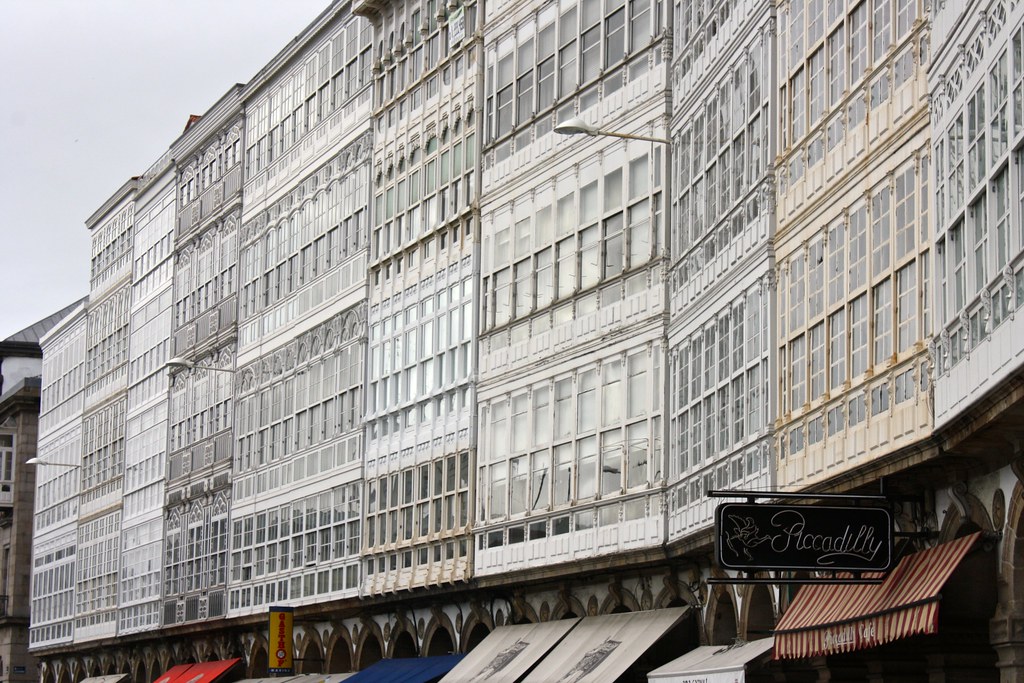 |
| A Coruña |
Arrive in A Coruña in the early morning and introduce yourself to Galicia at a local café-bar. A small plate of sugar-drizzled churros will get you started for breakfast. Spend your first day in Galicia by exploring Coruña’s old town, by checking out museums and military forts, and by strolling along the oceanfront promenade, where you can appreciate the beauty of the city’s galerías or glassed-in balconies that stretch from one house to the next. An essential part of any visit to the Glass City is the Tower of Hercules, a monumental lighthouse that has been in continuous use since Roman times. What to eat here? A mariscada, or seafood platter, that you can order at any of the restaurants behind the Praza de María Pita square.
Sleep in A Coruña
Day 2: Santiago de Compostela
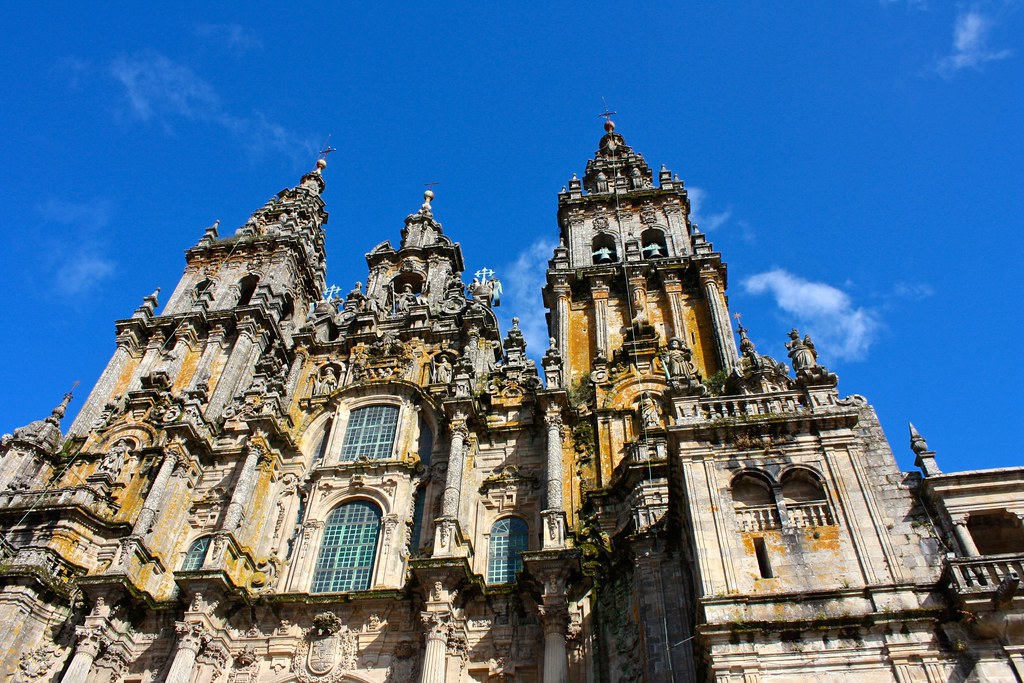 |
| Santiago de Compostela |
(Read my post on how to spend 24 hours in Santiago)
Take the high-speed train from Coruña south and arrive in Santiago de Compostela, the Galician capital, half an hour later. Convalesce over a cup of coffee at Café Venecia before ascending to the rooftop of the cathedral for a guided tour of this interesting religious complex. Wander through the granite-paved streets of the old town, making your way to the local market, where you can gawk at freshly-caught seafood and marvel at local delicacies like Padrón peppers. If it’s sunny, pick up ingredients for a picnic in Belvís Park; otherwise, have a menú del día (fixed-price lunch) at a restaurant on Rúa de San Pedro.
After an afternoon pick-me-up at Café Tertulia, go for a hike along the Sarela River or summit Mount Pedroso for panoramic views. In the evening, attend a pilgrim mass to watch the botafumeiro, a human-sized thurible, be swung across the transept. Finish your first day in Santiago by going on a pub crawl at tapas joints and historic cocktail bars in the old town.
Sleep in Santiago de Compostela
Day 3: western coast
 |
| Fisterra |
You probably had a late night in Santiago, so take this opportunity to sleep in. Once you’ve woken up, head out west to Fisterra, Galicia’s Lands End. Santiago may be the official ending point of the medieval pilgrimage route called the Camino de Santiago, but Fisterra, perched on a cliff overlooking the Atlantic Ocean, is its true terminus.
If you drive to Fisterra, there are several highlights you can check out between Santiago and Fisterra. The fishing villages of Noia and Muros are replete with Gothic churches, fish markets, and cozy restaurants to grab a bite to eat in. Further west, Carnota Beach stretches nearly 3 miles long, and not too far away trickles the Ézaro Waterfall, the only point in continental Europe where a river empties into the sea via a waterfall.
Sleep in Santiago de Compostela
Day 4: Rías Baixas
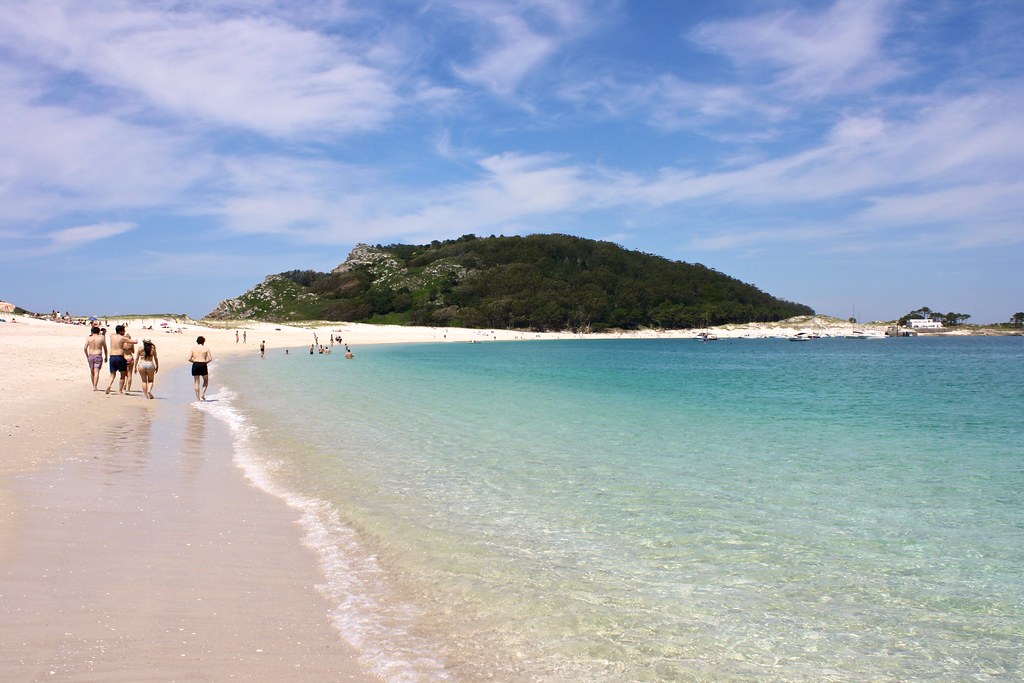 |
| Cíes Islands |
In “summer” months (i.e., Holy Week, May weekends, and June through November), take a daytrip to the Cíes Islands, a three-island archipelago protected under national park status. Ride the high-speed train down to Vigo, hop on a 45-minute ferry, and enjoy sunbathing on pristine white-sands beaches or hiking up wooded hillsides. Be sure to pack a picnic lunch so you don’t get gouged by the lone restaurant on the islands; I recommend empanada, a thin Galician meat pie.
The rest of the year, you can still enjoy the Rías Baixas or “lower estuaries” by exploring the villages and vineyards of the wine-producing region of the same name. Start in Pontevedra, a mid-sized city known for its charming plazas; check out Combarro, frequently included on lists of most beautiful villages in Spain; and wind down in Cambados, capital of the Rías Baixas wine region where Albariño grapes are grown.
Sleep in Santiago de Compostela
Day 5: Ourense
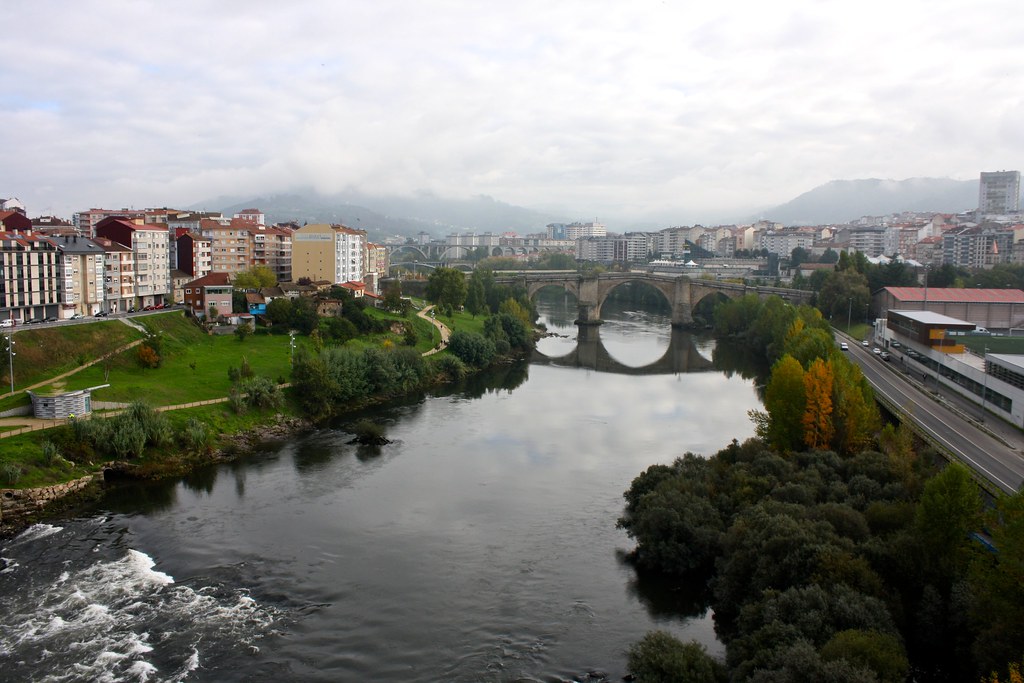 |
| Ourense |
It’s time to head to inland Galicia. Pack your bags and travel to Ourense, the region’s largest metro area not along the Atlantic coast. In the morning, stroll across the mighty Miño River via any of Ourense’s fabulous bridges, check out the cathedral and its well-preserved medieval sculpture, and take a dip in the riverside hot springs. Have Galician-style octopus in, contrary to what you’d expect, the best part of the region to enjoy it in—the interior.
After lunch, trace the Miño River up to one of its tributaries, the Sil River, which has carved a grand canyon out of the sheer granite bedrock. Take in the sweeping views but make sure to leave time to check out a couple of the numerous beautiful monasteries that were founded in this isolated region in the early Middle Ages. Pair your dinner at a local restaurant with a glass of local Ribeira Sacra wine.
Sleep in Ourense
Day 6: Lugo
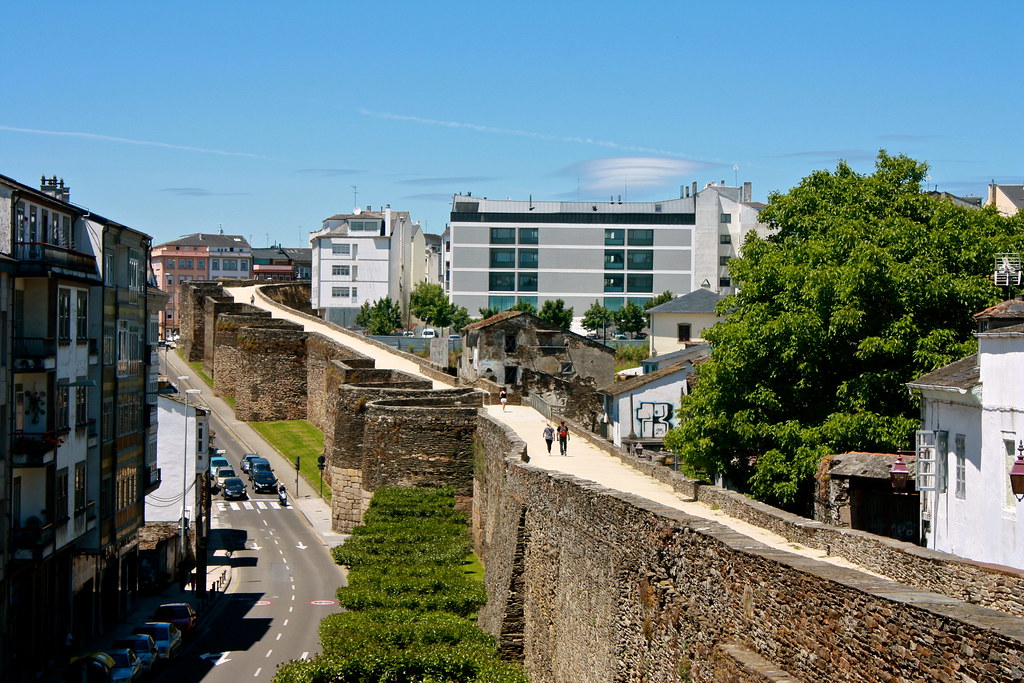 |
| Lugo |
Take your time in Ourense in the morning, maybe going for one last dip in the hot springs before moving north to Lugo. Like its neighbor to the south, Lugo’s also a great place to have pulpo á feira (octopus), so grab a wooden platter of the stuff for lunch right after arriving.
Lugo’s claim to fame is being the only city in the world still encircled by its original Roman walls, so spend the afternoon making your circuit around the old town at ground level—and on top of the walls, where there’s a nice footpath spanning the 2.1km-long walls. Explore the old town, step into the cathedral, peek into the odd museum or two. At night go out for (free) tapas, as in Lugo it’s customary to get not one but two free tapas—one hot and one cold—with whatever you get to drink. Before you go to bed, look up the schedule for the tides on the north Atlantic coast, ‘cause you’ll need it for tomorrow.
Sleep in Lugo
Day 7: northern coast
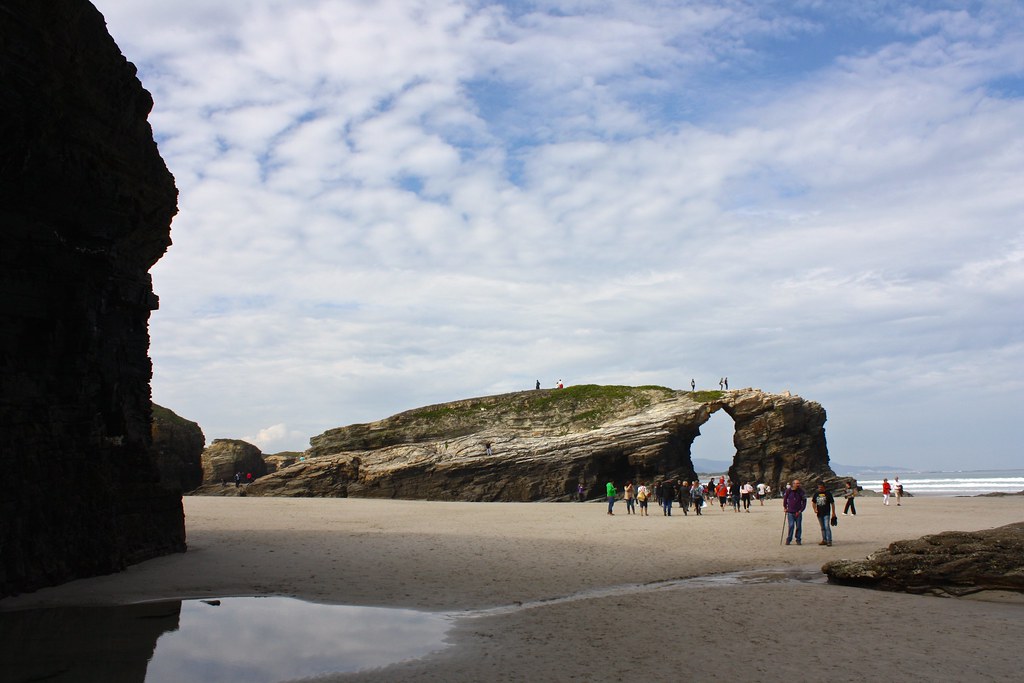 |
| Cathedrals Beach |
Make a beeline for the Atlantic, crossing your fingers that your visit to Praia das Catedrais, the “Cathedrals Beach,” coincides with low tide. Grab some fresh seafood in nearby Ribadeo. Continue on to your final destination: Betanzos. Wander around the old town, where you have your choice of several fine Gothic churches, and enjoy a slice of extra-runny Spanish potato omelet, a Betanzos specialty. Complete this seven-day circuit around Galicia by returning to A Coruña for the night.
Sleep in A Coruña